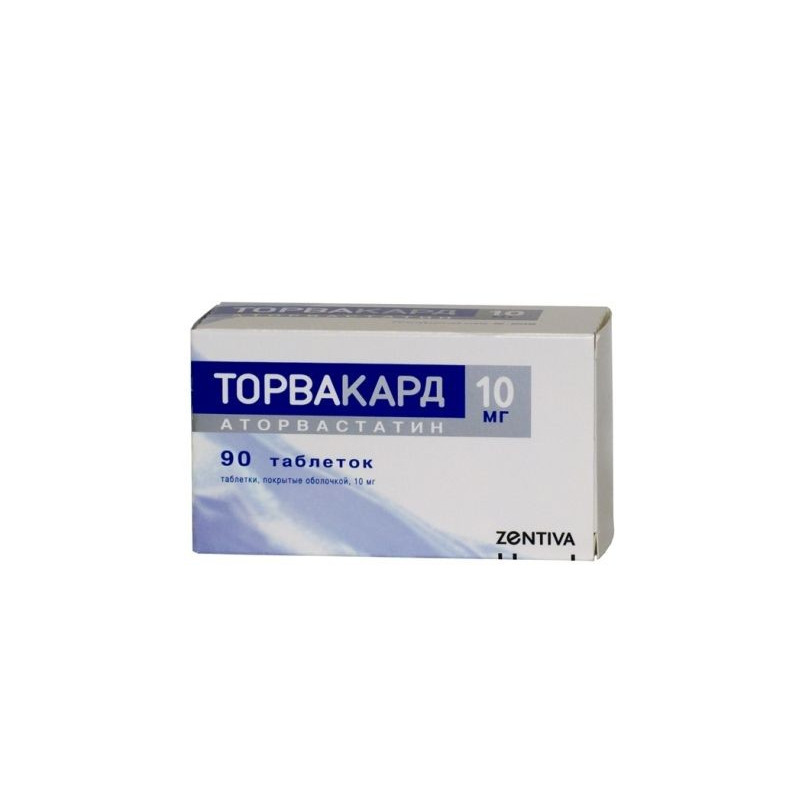



 All payments are encrypted via SSL
All payments are encrypted via SSL
 Full Refund if you haven't received your order
Full Refund if you haven't received your order
Torvacard coated tablets:
1 tab. contains Atorvastatin (in the form of Calcium salt) 10, 20 and 40 mg;
ExcipientsA: Magnesium oxide is heavy; MCC; lactose monohydrate; croscarmellose sodium; low substituted hydroxypropylcellulose LH21; colloidal silicon dioxide; magnesium stearate;
shell composition: hypromellose 2910/5; macrogol 6000; titanium dioxide; talc;
in the package 10, 30 and 90 pcs.
Torvacard has a lipid-lowering effect.
in combination with a diet to reduce elevated levels of total Xc, LDL-C, LDL, apolipoprotein B and TG and increase HD-C HDL in patients with primary hypercholesterolemia, heterozygous familial and non-familial hypercholesterolemia, and combined (mixed) hyperlipidemia (type IIa and IIb and IIb and IIb, I, and Ib).;
in combination with a diet for the treatment of patients with elevated serum TG levels (type IV according to Fredrickson) and patients with dysbetalipoproteinemia (type III according to Fredrickson), in whom diet therapy does not give an adequate effect;
to reduce the levels of total CS and LDL-LDL in patients with homozygous familial hypercholesterolemia, when diet therapy and other non-pharmacological treatment methods are not sufficiently effective.
hypersensitivity to the components of Torvacard;
active liver disease or increased serum transaminase activity (more than 3 times compared with the upper limit of the norm) of unclear genesis;
pregnancy;
lactation period;
children and adolescents under 18 years of age (efficacy and safety have not been established).
Carefully:
chronic alcoholism;
history of liver disease;
severe electrolyte imbalance;
endocrine and metabolic disorders;
hypotension;
severe acute infections (sepsis);
uncontrolled epilepsy;
extensive surgical interventions;
injuries;
skeletal muscle diseases.
Nervous system: headache, dizziness, asthenic syndrome, insomnia or drowsiness, nightmares, amnesia, paresthesias, peripheral neuropathy, emotional lability, ataxia, hyperkinesis, depression, hyperesthesia.
Special senses: amblyopia, tinnitus, dry conjunctiva, accommodation disturbance, hemorrhage in the eye, deafness, increased intraocular pressure, parosmia, taste perversion, loss of taste.
Cardiovascular: chest pain, palpitations, vasodilation, orthostatic hypotension, phlebitis, arrhythmia.
Hemic and lymphatic: anemia, lymphadenopathy, thrombocytopenia.
Respiratory: bronchitis, rhinitis, dyspnea, bronchial asthma, epistaxis.
Gastrointestinal: nausea, heartburn, constipation or diarrhea, flatulence, gastralgia, abdominal pain, anorexia or increased appetite, dry mouth, belching, dysphagia, vomiting, stomatitis, esophagitis, glossitis, gastroenteritis, hepatitis, hepatic colic, cheilitis, twelve, twelve, gastrointestinal, hepatitis, hepatic, hepatic colic, cheilitis, jaundice, pancreatitis, cholestatic jaundice, increased activity of liver enzymes, rectal bleeding, melena, gingival bleeding, tenesmus.
Musculoskeletal system: arthritis, leg muscle cramps, bursitis, myositis, myopathy, arthralgia, myalgia, rhabdomyolysis, joint contractures, back pain.
From the genitourinary system: urogenital infections, peripheral edema, dysuria (including pollakiuria, nocturia, urinary incontinence or urinary retention, urgency to urinate), nephritis, cystitis, hematuria, vaginal bleeding, uterine bleeding, urolithiasis, metrorrhagia, epididymitis, decreased libido, impotence, impaired ejaculation.
Dermatologic: alopecia, sweating, eczema, seborrhea, ecchymosis, photosensitization.
Allergic reactions: pruritus, skin rash, contact dermatitis; rarely - urticaria, angioedema, facial edema, anaphylaxis, erythema multiforme exudative, Stevens-Johnson syndrome, toxic epidermal necrolysis (Lyell's syndrome).
From the laboratory indicators: hyperglycemia, hypoglycemia, increased serum creatine phosphokinase, albuminuria, increased activity of ACT, ALT.
Other: weight gain, gynecomastia, exacerbation of the flow of gout, increased body temperature.
Before prescribing Torvacard, the patient should be advised to recommend a standard lipid-lowering diet, which he must continue to follow throughout the entire period of therapy.
The initial dose - an average of 10 mg 1 time per day. The dose varies from 10 to 80 mg 1 time per day. The drug can be taken at any time of the day with food or regardless of meal times. The dose is selected based on the initial levels of LDL-C, the goal of therapy and the individual effect. At the beginning of treatment and / or during the dose increase of Torvacard, it is necessary to monitor plasma lipid levels every 2–4 weeks and correct the dose accordingly.
Store in a cool and dark place, protected from light and moisture, at a temperature not higher than 25 ° C.
